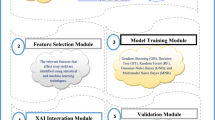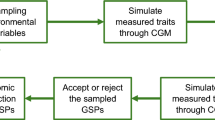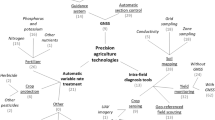Abstract
Crop yield maps are valuable for many applications in precision agriculture, but are often inaccessible to growers and researchers wishing to better understand yield determinants and improve site-specific management strategies. A method for mapping sub-field crop yields from remote sensing imagery could increase the availability of crop yield maps. A variation of the scalable crop yield mapping approach (SCYM, Lobell et al. in Remote Sensing of Environment 164:324–333, 2015) was developed and tested for estimating sub-field maize (Zea mays L.) yields at 10–30 m without the use of site-specific input data. The method was validated using harvester yield monitor records for 21 site-years for irrigated and rainfed fields in eastern Nebraska, USA. Prediction error ranged greatly across site-years, with relative RMSE scores of 10.8 to 38.5%, and R2 values of 0.003 to 0.37. Significant proportional bias was detected in the predictions, but could be corrected with a small amount of ground truth data. Crop yield prediction accuracies without calibration were suitable for some precision applications such as mapping relative yields and delineating management zones, but model improvements or calibration datasets are needed for applications requiring absolute yield estimates.










Similar content being viewed by others
References
Asseng, S., et al. (2013). Uncertainty in simulating wheat yields under climate change. Nature Climate Change,3, 827.
Azzari, G., Jain, M., & Lobell, D. B. (2017). Towards fine resolution global maps of crop yields: Testing multiple methods and satellites in three countries. Remote Sensing of Environment,202, 129–141.
Bernstein, L.S. et al. (2005). Validation of the QUick atmospheric correction (QUAC) algorithm for VNIR-SWIR multi- and hyperspectral imagery, Defense and Security, (p. 11), SPIE.
Bland, J. M., & Altman, D. G. (1999). Measuring agreement in method comparison studies. Statistical Methods in Medical Research,8(2), 135–160.
Burke, M., & Lobell, D. B. (2017). Satellite-based assessment of yield variation and its determinants in smallholder African systems. PNAS,114(9), 2189–2194.
Cassman, K. G. (1999). Ecological intensification of cereal production systems: Yield potential, soil quality, and precision agriculture. Proceedings of the National Academy of Sciences,96(11), 5952–5959.
Friedman, J. H. (2001). Greedy function approximation: A gradient boosting machine. Annals of Statistics,29(5), 1189–1232.
Gitelson, A. A., et al. (2003). Remote estimation of leaf area index and green leaf biomass in maize canopies. Geophysical Research Letters,30(5), 1248.
Godfray, H. C. J., & Garnett, T. (2014). Food security and sustainable intensification. Philosophical Transactions of the Royal Society B: Biological Sciences,369(1639), 20120273.
HarvestChoice (IFPRI), International Research Institute for Climate and Society and Michigan State University. (2015). Global high-resolution soil profile database for crop modeling applications, Harvard Dataverse.
Hengl, T., et al. (2014). SoilGrids1 km—Global soil information based on automated mapping. PLoS ONE,9(8), e105992.
Hijmans, R. J. (2016). raster: Geographic data analysis and modeling (version 2.5-8), pp. R package.
Hoogenboom, G. et al. (2015). Decision support system for agrotechnology transfer (DSSAT) version 4.6. DSSAT Foundation, Prosser, Washington.
Jain, M., et al. (2017). Using satellite data to identify the causes of and potential solutions for yield gaps in India’s Wheat Belt. Environmental Research Letters,12(9), 094011.
Jin, Z., Azzari, G., Burke, M., Aston, S., & Lobell, B. D. (2017a). Mapping smallholder yield heterogeneity at multiple scales in eastern Africa. Remote Sensing,9(9), 931.
Jin, Z., Azzari, G., & Lobell, D. B. (2017b). Improving the accuracy of satellite-based high-resolution yield estimation: A test of multiple scalable approaches. Agricultural and Forest Meteorology,247, 207–220.
Jones, J. W., et al. (2003). The DSSAT cropping system model. European Journal of Agronomy,18(3–4), 235–265.
Lobell, D. B., Thau, D., Seifert, C., Engle, E., & Little, B. (2015). A scalable satellite-based crop yield mapper. Remote Sensing of Environment,164, 324–333.
Masek, J. G., et al. (2013). LEDAPS calibration, reflectance, atmospheric correction preprocessing code, version 2. Oak Ridge, Tennessee, USA: ORNL DAAC.
Panda, S. S., Ames, D. P., & Panigrahi, S. (2010). Application of vegetation indices for agricultural crop yield prediction using neural network techniques. Remote Sensing,2(3), 673–696.
Peel, M. C., Finlayson, B. L., & McMahon, T. A. (2007). Updated world map of the Köppen-Geiger climate classification. Hydrology and Earth System Sciences,11(5), 1633–1644.
Peralta, N., Assefa, Y., Du, J., Barden, C., & Ciampitti, I. (2016). Mid-season high-resolution satellite imagery for forecasting site-specific corn yield. Remote Sensing,8(10):848.
Schepers, A. R., et al. (2004). Appropriateness of management zones for characterizing spatial variability of soil properties and irrigated corn yields across years. Agronomy Journal,96(1), 195–203.
Schimmelpfennig, D. (2016). Farm profits and adoption of precision agriculture. Economic Research Report ERR-217. USDA-ERS.
Sibley, A. M., Grassini, P., Thomas, N. E., Cassman, K. G., & Lobell, D. B. (2014). Testing remote sensing approaches for assessing yield variability among maize fields. Agronomy Journal,106, 24–32.
Simbahan, G., Dobermann, A., & Ping, J. L. (2004). Screening yield monitor data improves grain yield maps. Agronomy Journal,96(4), 1091–1102.
Suyker, A., 2016. AmeriFlux US-Ne1, 2, and 3 Mead, Nebraska, USA, United States.
Suyker, A. E., & Verma, S. B. (2009). Evapotranspiration of irrigated and rainfed maize–soybean cropping systems. Agricultural and Forest Meteorology,149(3–4), 443–452.
Thenkabail, P., Smith, R. B., & De Pauw, E. (2002). Evaluation of narrowband and broadband vegetation indices for determining optimal hyperspectral wavebands for agricultural crop characterization. Photogrammetric Engineering and Remote Sensing,68, 607–621.
Yang, C. (2015). Hyperspectral imagery for mapping crop yield for precision agriculture. In B. Park & R. Lu (Eds.), Hyperspectral imaging technology in food and agriculture (pp. 289–304). New York, New York, NY: Springer.
Yang, C., & Everitt, J. H. (2002). Relationships between yield monitor data and airborne multidate multispectral digital imagery for grain sorghum. Precision Agriculture,3(4), 373–388.
Zhang, N., Wang, M., & Wang, N. (2002). Precision agriculture—A worldwide overview. Computers and Electronics in Agriculture,36(2), 113–132.
Acknowledgements
This work was supported by the National Science Foundation under Grant #0966093, Integrative Graduate Education and Research Traineeship (IGERT) Program on Water Diplomacy at Tufts University. We thank the University of Nebraska – Lincoln’s Carbon Sequestration Program for sharing yield monitor data and the Center for Advanced Land Management Information Technologies (CALMIT) for providing AISA hyperspectral imagery.
Author information
Authors and Affiliations
Corresponding author
Additional information
Publisher's Note
Springer Nature remains neutral with regard to jurisdictional claims in published maps and institutional affiliations.
Electronic supplementary material
Below is the link to the electronic supplementary material.
Rights and permissions
About this article
Cite this article
Jeffries, G.R., Griffin, T.S., Fleisher, D.H. et al. Mapping sub-field maize yields in Nebraska, USA by combining remote sensing imagery, crop simulation models, and machine learning. Precision Agric 21, 678–694 (2020). https://doi.org/10.1007/s11119-019-09689-z
Published:
Issue Date:
DOI: https://doi.org/10.1007/s11119-019-09689-z




